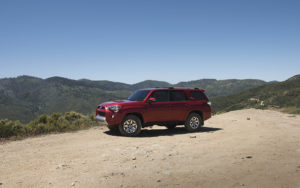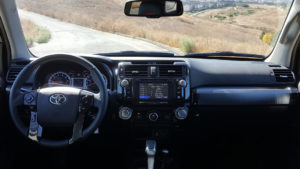Who Needs a Road?
This month’s article is the fourth answer to the question, “What type of vehicle works best for camping?” So far, we have reviewed a Crossover, a Minivan, and an AWD Wagon. This month we hit the trail with a 4×4 SUV.
For those readers who have missed my previous three articles, my goal is to look at four different types of vehicles and how they stack up to a camping adventure. All articles highlight the pros and cons of each vehicle category along with my personal camping experiences.
Our fourth vehicle category is the 4×4 SUV and our test vehicle is the 2017 Toyota 4Runner. I would like to start by sending out a thank you to Christine Henley of Toyota for helping me to secure my test vehicle at the last moment.
This camping adventure took my son and another father-son team deep into the back hills of Livermore, California for a Boy Scout excursion. As we hit the last couple of miles, I was elated to be behind the wheel of a 4×4-drive vehicle with the confidence and capability of the 2017 Toyota 4Runner 4X4 TRD Off-Road Premium.
Our scout camp was built in the 1940s and it doesn’t appear that the road was ever resurfaced or even well-maintained. You could almost hide a VW Beetle in some of the pot holes! Lucky for us, the 4Runner managed them with ease.
A group of four people out camping can require a lot of space to transport their equipment. The 4Runner (with slide deck) had more than enough room with 46.3 cubic feet of rear cargo space. If you are wondering what the “Slide Deck” is, well to help people load and remove items from the rear cargo area, Toyota created a “deck” that slides out above the floor, allowing for easy access and removal of your stuff. It was great when we had to load and unload our packed cooler from the back.
The 4Runner is one of the few truck-based, body-on-frame SUVs left on the market. Most have moved over to car-based frames called CUV or Crossovers. This structure allows the 4Runner to master some serious off-roading, as well as shuttling the family around town. It combines the characteristics of being refined, accommodating, and confident. One difference between an SUV and a CUV is the ride. SUVs ride like a truck, but also handle dirt-filled roads better.
Most recently redesigned for the 2014 model year, the 2017 Toyota 4Runner is stylish with a self-assured attitude. From north to south, the body is well-balanced. The front feels aggressive with its powerful grille and headlights resembling eyes that seem self-assured. The ground clearance on the 4×4 sits at 9.6-inches and you feel the height as your cruise down the road.
Inside of the 2017 4Runner, the center dash is boxed-framed with large knobs to control the radio and air systems. You’ll find off-road switches and knobs in an aircraft fashion near the dome lights.
I found the 4Runner, at least our trim level, to have a number of high-tech features, however, it left me without a push-start button. Door-mounted open buttons were nowhere to be seen, forcing me to grab for the keys each time I opened a door. The interior was comfortable, and the components were well-placed. A 110-volt plug was located in the rear compartment.
For 2017, the Toyota 4Runner comes in the following configurations: Limited (2WD and 4WD), SR5 (2WD and 4WD), SR5 Premium (2WD and 4WD), TRD Off-Road 4×4, TRD Off-Road Premium 4×4, and TRD Off-Road Pro 4×4.
All 4Runners are powered by the same power-plant, a 4.0-liter V-6 motor that generates 270 horsepower and 278 pound-feet of torque that is matted to a 5-speed automatic transmission. This combination works wells and easily transports you to your daily activities or up the next hill ridge. The 4Runner sits on top of the Tacoma chassis, but with a better suspension setup delivering an enhanced ride.
Cool Features:
- Slide Deck
- Bilstein custom off-road shocks (TRD PRO Series
- Rear Liftgate Power Window
The safety features are complete with Vehicle Stability Control (VSC), Traction Control (TRAC), Anti-lock Brake System (ABS), Electronic Brake-force Distribution (EBD), Brake Assist (BA) and Smart Stop Technology (SST)®, driver and front passenger Advanced Airbag System, driver and front passenger TAP, front seat-mounted side airbags, driver and front passenger knee airbags, and front and all row (third-row airbags on all models) roll-sensing side curtain airbags (RSCA), driver and front passenger active headrests, anti-theft alarm system with an engine immobilizer, Front and Rear Parking Assist Sonar (Limited only), Hill Start Assist Control, Downhill Assist Control (SR5 and Limited 4×4 only), and Tire Pressure Monitor System (TPMS).
In Summary –The 2017 Toyota 4Runner is a wonderful vehicle if you’re looking for the sturdiness of a truck-based platform with, as my little scout would say, “Pro-skills” when driving off-payment. The 4Runner is blended with high-tech and off-road features that will take care of your needs. It may not ride like a car, but the buyers of the 4Runner aren’t expecting or wanting it to. They desire the independence and adept ability to master the beaten path.
This is the end of my 2017 Camping Vehicle Series. I hope you have enjoyed it.
Specifications
2017 Toyota 4Runner 4X4 TRD Off-Road Premium
Base price: $39,295as driven: $42,455(including destination & optional
features)
Engine: 4.0-liter 6-Cylinder
Horsepower: 270 hp
Torque: 278 lb.-ft.
Transmission: 5-speed automatic
Drive: 4-Wheel Drive
Seating: 5-passenger (7-passenger with the optional third row seats)
Ground Clearance: 9.0-inches
Cargo space: 46.3 cubic feet
Curb weight: 4,675pounds
EPA mileage: City 17/Hwy 21/Comb 18 MPG
Wheel Base: 109.8inches
Warranty: 3 years/36,000-miles
Also consider: Ford Explorer, Jeep Grand Cherokee, Nissan Pathfinder
Leave a Reply